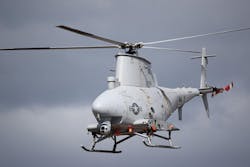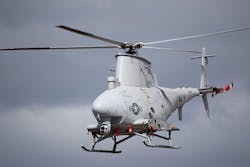Multispectral UAV sensor payloads help Marines find hidden beach mines
PANAMA CITY, Fla. — Electro-optics experts at Arete Associates in Northridge, Calif., are building multispectral unmanned aircraft sensor payloads to help unmanned helicopters detect and pinpoint enemy mines and obstacles in beach surf zones to help keep Marines safe during amphibious attacks.
Officials of the Naval Surface Warfare Center Panama City Division in Panama City, Fla., announced a $17.1 million order to build AN/DVS-1 Coastal Battlefield Reconnaissance and Analysis (COBRA) systems.
Carried onan unmanned helicopter, the sensor system has limited detection capability in the surf zone. COBRA will be deployed from the littoral combat ship and is an integral part of the ship’s mine countermeasures mission package.
Arete Associates in Northridge, Calif., is building multispectral unmanned aircraft sensor payloads to help unmanned helicopters detect enemy mines and obstacles.
COBRA uses multispectral sensors to conduct unmanned aerial tactical reconnaissance to detect and localize mine fields and obstacles in the surf zone and beach zone prior to amphibious assault.
A multispectral image contains data within specific wavelength ranges to extract information the human eye fails to capture with its receptors for red, green and blue. It measures light in 3 to 15 spectral bands to help detect otherwise-invisible mines.
The AN/DVS-1 COBRA passive multispectral sensor system is for unmanned helicopters to perform daytime surface-laid mine line and obstacle detection in the beach zone, and has off-board processing, Arete experts say.
The COBRA payload includes stabilized step stare digital gimbal, high-resolution multispectral imaging digital camera with spinning six-color filter wheel, and a processing unit.
The gimbal is about 19 inches long and 11 inches in diameter, and collects six different color-band images across a large area using a step-stare pattern. At the mission, personnel load its data storage unit into a post mission analysis station.
COBRA began as a U.S. Marine Corps advanced technology program in the 1990s. The system uses incremental development, with three initial blocks of development planned with each introducing new or enhanced capabilities. On this order Arete Associates will do the work in Tucson, Ariz.; Destin, Fla.; and Santa Rosa, Calif., and should be finished by July 2021.
For more information contact Arete Associates online at http://arete.com, or the Naval Surface Warfare Center Panama City Division at www.navsea.navy.mil/Home/Warfare-Centers/NSWC-Panama-City.

